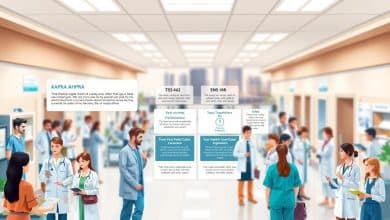Norway Skilled Worker Visa Sponsorship: engineers & IT roles — UDI income thresholds, job-offer requirements and work-rights
For technical professionals seeking international career growth, certain European destinations offer exceptional pathways.
This comprehensive guide explores the process for qualified individuals in engineering and technology fields to pursue employment opportunities abroad.
The system targets individuals with specialized qualifications, particularly those holding university degrees in technical disciplines. Professionals with backgrounds in engineering, computer science, and related fields find these programs particularly accessible.
This resource covers essential requirements including income thresholds that vary by educational level. Readers will understand job offer necessities, including full-time position requirements with registered employers. The article also explores work rights granted to permit holders, including duration and family options.
Drawing from official guidelines and current regulations, this serves as a roadmap for both prospective employees and employers interested in international talent acquisition for technical roles.
Introduction to Norway Skilled Worker Visa Sponsorship
For engineers and IT experts considering overseas positions, clear guidance on legal requirements is essential. This resource provides comprehensive information about the authorization process for technical professionals.
Purpose and Scope of the Guide
This guide delivers actionable details for navigating the immigration system. It focuses specifically on employer-sponsored pathways for qualified individuals.
The scope covers the complete journey from initial assessment to post-arrival registration. Readers gain understanding of eligibility criteria and application procedures.
Key areas addressed include documentation requirements and compliance obligations. The information helps both applicants and employers navigate the process successfully.
Target Audience and Key Considerations
Primary readers include technical professionals from outside the EU/EEA seeking employment. HR managers and immigration advisors also benefit from this resource.
Important considerations highlight that remote work requires formal authorization. Successful applications demand coordinated effort between employees and employers.
Technical specialists benefit from strong demand for their skills and clear pathways to long-term residence. Understanding these advantages helps in planning career moves.
Understanding the “Norway skilled worker visa sponsorship” Process
Companies seeking to hire global talent must comprehend the sponsorship mechanism that facilitates legal employment. This employer-driven system establishes a formal relationship between the hiring organization and foreign professionals.
The framework ensures proper documentation and compliance with national regulations. Organizations play a critical role in enabling international recruitment.
Role of the Sponsor and Employer
Registered entities bear significant responsibilities in this process. They must maintain valid organizational registration and demonstrate legitimate operations.
Employers provide accurate contracts meeting salary thresholds and Norwegian standards. Some positions require labor-market testing to prove local talent shortages.
The authorization process typically takes one to two months. Companies without local presence can use Employer of Record services for compliance.
Key Benefits and Challenges
Organizations gain access to specialized technical professionals worldwide. This addresses difficult-to-fill roles and enhances workforce diversity.
Professionals receive competitive compensation and strong labor protections. Clear pathways to permanent residence exist after three years of employment.
Challenges include complex documentation and varying processing times. Strict compliance requirements demand ongoing monitoring of employment conditions.
Eligibility and Qualifications Requirements
A successful application hinges on meeting one of three distinct qualification categories set by immigration authorities. Each pathway has specific criteria that an applicant must meet to prove their competence.
The three primary pathways to demonstrate necessary qualifications are:
- Vocational Training: This requires at least three years of upper secondary school-level training in a field with a Norwegian equivalent.
- University Education: A completed degree from a recognized university or college, such as a bachelor’s in engineering, meets this requirement.
- Professional Experience: This path demands special qualifications gained through typically six or more years of documented work.
Educational Background and Vocational Training
For technical roles, a university degree is the most straightforward path. Engineering and IT qualifications like computer science or data science are highly recognized.
Vocational training is a valid route but less common for these advanced positions. The field of study must have a direct equivalent program.
Special Qualifications Through Professional Experience
This is the most challenging pathway. The applicant must meet a very high standard, proving their experience is equal to formal education.
Detailed work certificates are essential. They must outline specific skills, responsibilities, and competencies acquired over the years.
Approval for this route is difficult. Authorities scrutinize these applications heavily, especially from certain countries, due to fraud concerns.
Job Offer Requirements for Engineers and IT Professionals
Employment validation serves as the primary gateway for technical specialists seeking authorization. Applicants must present a concrete job offer from a specific registered employer to proceed with their application.
The offered position must align with the applicant’s qualifications and typically require full-time commitment. However, roles comprising at least 80% of standard working hours are also acceptable.
Full-Time versus 80% Positions
Standard employment arrangements demand full-time engagement, but flexibility exists for specialized consulting roles or senior positions. The 80% threshold equates to approximately four working days per week.
Technical professionals in engineering and IT fields qualify for various positions. These include software developers, data scientists, cybersecurity specialists, and multiple engineering disciplines.
The job offer documentation must detail specific terms including salary, working conditions, and start date. All conditions must meet or exceed local labor standards for comparable jobs.
UDI Income Thresholds and Salary Conditions
Compensation standards play a crucial role in employment authorization for technical professionals. The system establishes clear financial benchmarks that employers must meet when hiring qualified individuals.
These requirements ensure fair treatment and maintain labor market standards. They apply to various qualification levels with specific amounts for each category.
Minimum Salary and Pre-tax Income Requirements
Different educational backgrounds trigger distinct salary thresholds. Positions requiring master’s degrees must offer at least NOK 480,900 annually. Roles needing bachelor’s degrees have a minimum of NOK 448,900 per year.
These figures represent gross amounts before tax deductions. The pre-tax nature means employers must meet these baseline numbers regardless of subsequent withholdings.
The salary requirements serve multiple important purposes. They prevent wage dumping that could disadvantage local workers. They also ensure foreign employees can support themselves adequately.
Employers must demonstrate that compensation aligns with Norwegian industry standards. Authorities may verify this through salary surveys or collective agreements. Offering above minimum levels can strengthen application credibility.
Self-employed professionals face similar financial thresholds. They must prove likely annual income of at least NOK 325,400. This requires detailed business plans and financial projections.
Documenting and Validating Educational Credentials
Credential verification stands as one of the most scrutinized aspects of international employment applications. Proper documentation ensures qualifications meet established standards.
Immigration authorities carefully examine all submitted materials. They look for authenticity and completeness in every application.
Common Documentation Pitfalls
Many applicants encounter challenges with their submission materials. Unclear copies often cause processing delays. Missing official stamps or signatures create additional hurdles.
Translation errors represent another frequent issue. Documents must match exactly between original and translated versions. Complete academic transcripts showing courses and grades are essential.
Certain regions face heightened scrutiny due to past incidents. Applications from these areas require extra verification steps. This affects processing timelines significantly.
Ensuring Legitimate Certifications
Technical professionals should verify their university’s recognition status. International databases help confirm institutional legitimacy. Well-known technical institutions typically process more smoothly.
Supplementary materials strengthen an applicant’s case. Professional licenses and membership in engineering bodies add credibility. Published research or confirmation letters from educational institutions provide additional support.
All documents must be genuine before submission. Discovery of fraudulent credentials leads to automatic rejection. This may result in future application bans.
Navigating Employment Conditions and Work Rights
Understanding the specific conditions and rights attached to an employment authorization is vital for long-term planning. The terms of the permit directly govern where and how an individual can work.
The initial duration of the residence permit depends on the required qualifications for the position. Roles needing a university degree typically grant permits for up to three years. Positions based on vocational training are usually approved for one year at a time.
This authorization is tied to a specific job and employer. However, flexibility exists for career advancement. Changing to an identical type of work with a new company does not require a new application. The individual must simply notify the police within seven days.
A shift to a different type of employment, however, mandates a completely new permit application. Starting the new role before approval constitutes unauthorized work.
After three continuous years of legal residence, individuals become eligible to apply for permanent residence. This provides significant long-term stability.
Job loss protections are also in place. If a position ends, the permit holder can stay for up to six months to seek new employment. They must inform the police within one week of termination.
Remote work for other companies is not permitted unless it was part of the original approved job description. The permit holder’s family members also have the right to apply for residence permits to join them.
Step-by-Step Guide to the Visa Application Process
The submission process for employment authorization follows a structured sequence with specific requirements at each stage. Technical professionals must complete both digital and in-person components to secure approval.
Gathering the Required Documentation
Preparation begins with collecting essential paperwork. Individuals need a valid passport with adequate remaining validity. Educational certificates and detailed transcripts must be ready for submission.
The employment contract serves as a critical component. It should specify position details, salary meeting requirements, and working conditions. Additional documents include criminal record checks and accommodation proof.
Filing the Online Application and Paying Fees
The digital submission occurs through the official portal. Applicants or employers complete detailed forms about qualifications and employment terms. All documents upload in PDF format during this stage.
Payment of approximately NOK 6,300 accompanies the online submission. After digital filing, individuals schedule embassy appointments for identity verification. Processing typically requires several weeks before authorization grants.
Working before official approval constitutes unauthorized employment with serious consequences.
Employers can manage the entire process through specialized service providers. This ensures proper document preparation and compliance tracking throughout the authorization journey.
Addressing Fraud and Verification Concerns
Enhanced verification measures now impact processing timelines for applicants from certain regions with documented fraud patterns. Immigration authorities have implemented stricter controls following numerous incidents of falsified credentials.
Applications from specific countries face additional scrutiny. These include Bangladesh, China, India, Iran, Kosovo, Nepal, Pakistan, Turkey, and Vietnam.
Vocational positions encounter the most significant challenges. Restaurant, automotive, and construction industries see extended processing times. Roles like chef, mechanic, and carpenter require thorough document validation.
Technical professionals with university degrees typically experience smoother processing. However, applicants from high-risk countries should anticipate longer wait times. Additional verification steps may include direct institution contact or third-party credential evaluation.
To minimize delays, applicants should provide supplementary evidence. Professional licenses and employer reference letters strengthen applications. Complete, clear documentation helps avoid processing hurdles.
Employers sponsoring workers from affected regions should maintain open communication. Prompt responses to verification requests prevent application abandonment. Patience is essential during this due diligence process.
Special Cases: Offshore, Religious, and Self-Employed Workers
Certain employment categories follow distinct authorization pathways with specialized requirements. These unique situations demand careful attention to specific documentation and approval processes.
Four main special categories exist with their own rules. Each has different eligibility criteria and application procedures.
Distinct Documentation and Process Requirements
Offshore personnel on mobile installations may qualify for exemptions. They must report within one week and stay under 90 days per six-month period.
Otherwise, these workers apply through one of three permit types. These include assignments with international companies or foreign employers.
Religious leaders and teachers represent another specialized category. They typically need master’s degrees in religion or pedagogy from recognized institutions.
Self-employed persons must operate as sole proprietors rather than limited companies. They need to demonstrate projected annual income meeting minimum thresholds.
Athletes and coaches require confirmation from sports associations. This verifies their qualification level and competitive standard.
Each special category has unique renewal requirements and pathways to permanent residence.
These workers often face different documentation demands than standard employees. Business plans, financial projections, and market analysis may be necessary.
Understanding these distinct processes helps applicants choose the correct pathway. Proper preparation ensures smoother authorization for specialized work situations.
Sponsorship Essentials for Employers
Companies expanding their technical teams internationally must understand the fundamental sponsorship obligations required for legal hiring. These requirements ensure proper documentation and compliance with national regulations.
Organizations play a critical role in enabling international recruitment. They must meet specific criteria to qualify as sponsors.
Legal Entity Requirements and Registration
Every sponsoring entity needs proper registration with Norwegian authorities. This includes obtaining a valid organizational number from the official business registry.
The company must demonstrate legitimate operations and financial stability. There are no fixed capital requirements, but the business must prove it can sustain employment relationships.
Key registration elements include:
- Valid organizational number from Brønnøysund Register Centre
- Proof of active operational status
- Documentation of legitimate business activities
Conducting Labor-Market Tests and Compliance
Some positions require demonstrating that no suitable local candidates were available. This involves advertising through Norwegian employment channels.
Employers must maintain thorough documentation of their recruitment efforts. This includes job advertisements, application records, and interview notes.
Compliance responsibilities extend throughout the employment period. Companies must ensure salary payments meet established thresholds and notify authorities of any changes.
Processing Times and Tips for Streamlined Applications
The duration required for authorization decisions varies significantly based on multiple factors. Standard processing typically takes two to four months from submission to final decision.
University-educated technical professionals often experience shorter waiting periods of two to three months. Enhanced document verification for certain qualifications can extend this time frame.
Applications from specific regions may face additional scrutiny. This can add four to eight weeks to the standard processing period.
Submitting complete documentation packages initially prevents delays. Proper translations and detailed employment contracts help streamline the review process.
Employers should prepare thorough job descriptions that clearly demonstrate need for specialized qualifications. This helps authorities understand the position requirements quickly.
Booking biometric appointments promptly after online submission prevents scheduling bottlenecks. Some consulates have limited availability requiring advance planning.
Responding to information requests within five business days maintains application momentum. Delayed responses can add months to the total processing time.
Professional immigration services with established relationships can improve efficiency. They understand common pitfalls and prepare applications to meet expectations.
Realistic planning allows three to four months from job offer to work start date. This accommodates both authorization processing and personal relocation preparations.
Overcoming Challenges and Common Pitfalls in the Visa Process
Many employment authorization submissions face rejection due to preventable documentation errors. Technical professionals encounter specific hurdles when pursuing international career opportunities through this pathway.
Common issues include incomplete applications and salary offers falling below established thresholds. Many applicants struggle with proving their qualifications, especially when relying on professional experience rather than formal education.
Starting employment before receiving official approval constitutes illegal work. This results in immediate consequences including deportation and future application bans. Changing to different job types requires completely new authorization.
Documentation quality often creates major obstacles. Problems include unclear photocopies, incomplete transcripts, and mismatched translations. Credentials from certain countries require proper legalization.
Employment contracts must clearly demonstrate the need for specialized qualifications. Vague job descriptions trigger questions about whether the position genuinely requires advanced skills.
Overcoming these challenges requires thorough preparation. Applicants should evaluate credentials before submission and ensure contracts meet all requirements. Building buffer time into hiring plans accommodates potential processing delays.
Strategic Advice for Long-term Employment and Permanent Residency
Long-term career planning requires understanding how employment authorization evolves into permanent settlement rights. Technical professionals can optimize their career trajectory by strategically navigating the transition from temporary to indefinite stay.
Pathways to Permanent Residence
After three continuous years of legal residence, individuals become eligible to apply for permanent status. This period requires maintaining valid authorization throughout without significant absences.
The application process demands meeting several criteria beyond just time requirements. Applicants must demonstrate sustained employment, financial self-sufficiency, and basic language proficiency.
Permanent residence offers substantial benefits including indefinite stay rights without renewal needs. It also provides freedom to change employers and access to full welfare benefits.
Managing Job Changes Without Reapplying
Understanding position classification is crucial for career mobility. Moving to a similar role with a new employer requires only police notification within seven days.
This maintains continuity toward the three-year permanent residence threshold. However, switching to different position types triggers new authorization requirements.
Strategic career moves should consider how changes affect immigration status. Lateral moves within the same field proceed smoothly, while significant role changes may reset timelines.
Conclusion
Navigating international employment opportunities requires careful planning and understanding of regulatory frameworks. The system provides clear pathways for technical professionals with specialized qualifications. It offers predictable timelines and structured requirements for both applicants and employers.
Key elements include minimum salary thresholds, proper documentation, and employer compliance. University-educated engineers and IT specialists benefit from relatively straightforward processes. The framework balances access to global talent with protection of local labor standards.
Long-term prospects include pathways to permanent residence after three years of continuous employment. This transforms temporary authorization into stable settlement options. The strong demand for technical expertise makes this an opportune time for qualified professionals to explore these opportunities.
For more information, explore the official visa website mentioned in this article:
You will be redirected to another website
FAQ
What is the minimum salary required for an engineer or IT professional applying for this permit?
The Norwegian Directorate of Immigration (UDI) sets an annual income threshold. For most applicants, the pre-tax salary must be at least equal to that of a similar position under a collective agreement or be considered standard for the industry. It must also meet the minimum pay requirement set by the UDI, which is typically adjusted annually.
Can a part-time job offer qualify for the skilled worker permit?
An employment contract must be for a full-time position, which is generally defined as 80% or more of a standard 37.5-hour work week. Offers for less than 80% are usually not accepted for this specific immigration pathway.
What happens if I need to change employers after receiving my permit?
A new application must be submitted if you change employers. The new company must be registered with the Norwegian Register of Business Enterprises and provide a valid job offer. The individual must still meet all the original qualifications and salary conditions.
How long does the application process typically take?
Processing times can vary based on the completeness of the documentation and case load at the UDI. Applicants can check current estimated waiting periods on the official UDI website. Providing all required paperwork correctly can help avoid delays.
Is a university degree mandatory, or can professional experience substitute for formal education?
Either a completed degree from a university or university college, or special qualifications proven through substantial work experience, can fulfill the requirements. The experience must be documented and relevant to the specific job role.
What are the key documents an employer needs to provide for sponsorship?
The employer must supply a signed employment contract detailing salary, position, and work hours. They must also confirm their registration as a legitimate legal entity in Norway and demonstrate compliance with all national terms of employment.
After how many years can one apply for permanent residence?
Generally, an individual can apply for permanent residency after legally living and working in the country for three consecutive years. This requires holding valid permits and meeting other criteria, such as language proficiency.
Published on: 17 de October de 2025







